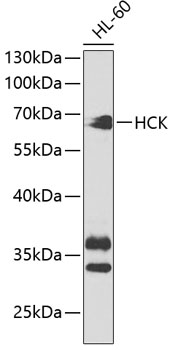Anti-HCK Antibody (CAB2083)
- SKU:
- CAB2083
- Product type:
- Antibody
- Reactivity:
- Human
- Host Species:
- Rabbit
- Isotype:
- IgG
- Research Area:
- Cell Biology
Description
| Antibody Name: | Anti-HCK Antibody |
| Antibody SKU: | CAB2083 |
| Antibody Size: | 20uL, 50uL, 100uL |
| Application: | WB IHC IF |
| Reactivity: | Human |
| Host Species: | Rabbit |
| Immunogen: | Recombinant fusion protein containing a sequence corresponding to amino acids 1-220 of human HCK (NP_001165600.1). |
| Application: | WB IHC IF |
| Recommended Dilution: | WB 1:500 - 1:2000 IHC 1:50 - 1:200 IF 1:10 - 1:100 |
| Reactivity: | Human |
| Positive Samples: | HL-60 |
| Immunogen: | Recombinant fusion protein containing a sequence corresponding to amino acids 1-220 of human HCK (NP_001165600.1). |
| Purification Method: | Affinity purification |
| Storage Buffer: | Store at -20°C. Avoid freeze / thaw cycles. Buffer: PBS with 0.02% sodium azide, 50% glycerol, pH7.3. |
| Isotype: | IgG |
| Sequence: | MGCM KSKF LQVG GNTF SKTE TSAS PHCP VYVP DPTS TIKP GPNS HNSN TPGI REAG SEDI IVVA LYDY EAIH HEDL SFQK GDQM VVLE ESGE WWKA RSLA TRKE GYIP SNYV ARVD SLET EEWF FKGI SRKD AERQ LLAP GNML GSFM IRDS ETTK GSYS LSVR DYDP RQGD TVKH YKIR TLDN GGFY ISPR STFS TLQE LVDH YKKG NDGL CQKL SVPC |
| Gene ID: | 3055 |
| Uniprot: | P08631 |
| Cellular Location: | Cell junction, Cell membrane, Cell projection, Cytoplasm, Cytoplasmic vesicle, Golgi apparatus, Lipid-anchor, Lysosome, Membrane, Nucleus, caveola, cytoskeleton, cytosol, cytosol, focal adhesion, podosome membrane, secretory vesicle |
| Calculated MW: | 57kDa/59kDa |
| Observed MW: | 65kDa |
| Synonyms: | HCK, JTK9, p59Hck, p61Hck |
| Background: | The protein encoded by this gene is a member of the Src family of tyrosine kinases. This protein is primarily hemopoietic, particularly in cells of the myeloid and B-lymphoid lineages. It may help couple the Fc receptor to the activation of the respiratory burst. In addition, it may play a role in neutrophil migration and in the degranulation of neutrophils. Multiple isoforms with different subcellular distributions are produced due to both alternative splicing and the use of alternative translation initiation codons, including a non-AUG (CUG) codon. |
| UniProt Protein Function: | Hck: a protein-tyrosine kinase of the Src family that is predominantly expressed in hemopoietic cell types. The encoded protein may help couple the Fc receptor to the activation of the respiratory burst. In addition, it may play a role in neutrophil migration and in the degranulation of neutrophils. Alternate translation initiation site usage, including a non-AUG (CUG) codon, results in the production of two different isoforms that have different subcellular localization. |
| UniProt Protein Details: | Protein type:Oncoprotein; EC 2.7.10.2; Protein kinase, TK; Kinase, protein; Protein kinase, tyrosine (non-receptor); TK group; Src family Chromosomal Location of Human Ortholog: 20q11-q12 Cellular Component: Golgi apparatus; transport vesicle; extrinsic to internal side of plasma membrane; cell projection; focal adhesion; lysosome; actin filament; caveola; nucleus; cytosol Molecular Function:protein binding; protein-tyrosine kinase activity; non-membrane spanning protein tyrosine kinase activity; ATP binding; receptor binding Biological Process: integrin-mediated signaling pathway; respiratory burst after phagocytosis; peptidyl-tyrosine phosphorylation; viral reproduction; protein amino acid autophosphorylation; cytokine and chemokine mediated signaling pathway; regulation of phagocytosis; protein amino acid phosphorylation; regulation of defense response to virus by virus; regulation of cell shape; leukocyte migration during immune response; positive regulation of actin filament polymerization; regulation of transcription factor activity; leukocyte degranulation; positive regulation of cell proliferation; regulation of inflammatory response; lipopolysaccharide-mediated signaling pathway; innate immune response; mesoderm development; cell differentiation; inflammatory response; innate immune response-activating signal transduction; cell adhesion; transmembrane receptor protein tyrosine kinase signaling pathway; negative regulation of apoptosis |
| NCBI Summary: | The protein encoded by this gene is a member of the Src family of tyrosine kinases. This protein is primarily hemopoietic, particularly in cells of the myeloid and B-lymphoid lineages. It may help couple the Fc receptor to the activation of the respiratory burst. In addition, it may play a role in neutrophil migration and in the degranulation of neutrophils. Multiple isoforms with different subcellular distributions are produced due to both alternative splicing and the use of alternative translation initiation codons, including a non-AUG (CUG) codon. [provided by RefSeq, Feb 2010] |
| UniProt Code: | P08631 |
| NCBI GenInfo Identifier: | 20141296 |
| NCBI Gene ID: | 3055 |
| NCBI Accession: | P08631.5 |
| UniProt Secondary Accession: | P08631,Q29RX1, Q2VPE2, Q504R5, Q5T7K1, Q5T7K2, Q96CC0 Q9H5Y5, Q9NUA4, A8K1I1, B4DQB6, E1P5M2, |
| UniProt Related Accession: | P08631 |
| Molecular Weight: | 526 |
| NCBI Full Name: | Tyrosine-protein kinase HCK |
| NCBI Synonym Full Names: | HCK proto-oncogene, Src family tyrosine kinase |
| NCBI Official Symbol: | HCK |
| NCBI Official Synonym Symbols: | JTK9; p59Hck; p61Hck |
| NCBI Protein Information: | tyrosine-protein kinase HCK; p59-HCK/p60-HCK; hemopoietic cell kinase; hematopoietic cell kinase |
| UniProt Protein Name: | Tyrosine-protein kinase HCK |
| UniProt Synonym Protein Names: | Hematopoietic cell kinase; Hemopoietic cell kinase; p59-HCK/p60-HCK; p59Hck; p61Hck |
| Protein Family: | Tyrosine-protein kinase |
| UniProt Gene Name: | HCK |
| UniProt Entry Name: | HCK_HUMAN |




